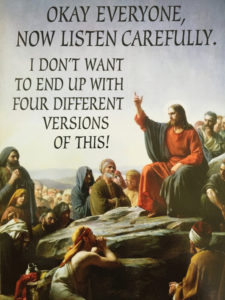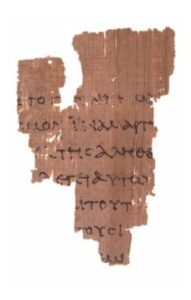May 23, 2018
This is a summary of a talk Artificial Intelligence and its implications on ethics today. The talk was given by Tom Daly to Reasonable Faith Adelaide on the 12th of April 2018.
 The talk can be viewed on You Tube and you can access the slides here.
The talk can be viewed on You Tube and you can access the slides here.
(more…)
March 25, 2018
1 Introduction
1.1 The 4 gospels
The New Testament starts with the 4 gospels: Matthew, Mark Luke and John. Each gospel also provides unique material. For example, only Luke gives us the parable of the prodigal son and only Matthew tells us about the visit by the Magi, but, some material is repeated. I have sometimes reacted, “Ho hum, boring! I have heard this all before”, but I was wrong.

(more…)
January 2, 2017
This presentation is available on You tube.

Papyrus P52
Introduction
The New Testament (NT) manuscripts are defined as those manuscripts that are still extant that were copied manually prior to the invention of the printing press. This article gives an overview of the New Testament manuscripts. It is a summary of a talk that is view-able on YouTube.
This article covers:
- Writing Forms,
- New Testament Papyri,
- Highly Significant Papyri,
- The great uncial codices,
- Criticisms of the manuscript record, and
- The significance of the NT manuscripts.
(more…)
March 1, 2016
This is a summary of David Turnbull’s presentation on Australian Spirituality on the 25th February 2016. A video of his presentation will be available from our You Tube site.

David Turnbull
My personal cross-cultural journey over five decades has established my belief that evangelism and apologetics are influenced by the context and require a cross-cultural communication framework. The goal is twofold –
- Reduce the noise that prevents the hearing of the message, and
- Present the message in a manner (verbal and non-verbal) that enables the audience/hearers/respondents to decode what was encoded rather than block the message through the heavy use of filters.
(more…)
November 5, 2015
The nature of religious intolerance in the early modern Era
By Matt Gray
On the 10th of September Matt Gray spoke to our Reasonable Faith group on ‘the nature of religious intolerance in the early modern era’ and the proposition that enlightenment secularism ushered in a greater level of tolerance in early modern Europe.

Pride and Prejudice by Jane Austen
(more…)
September 6, 2015
The Resurrection

“The Incredulity of Saint Thomas” by Michelangelo Merisi da Caravaggio (1601-1602)
“That which was from the beginning, which we have heard, which we have seen with our eyes, which we have looked at and our hands have touched—this we proclaim concerning the Word of life. The life appeared; we have seen it and testify to it, and we proclaim to you the eternal life, which was with the Father and has appeared to us.” 1 John 1:1-2
This is a summary of Steve White’s presentation on an argument for the resurrection on the 27th August 2015. (more…)
January 29, 2015
On the 18th of September Dr. Stephen Spence, professor of New Testament studies and theology at Tabor College, spoke at Reasonable Faith Adelaide about the nature of the oral tradition that is behind the New Testament and about how we can date when the New Testament documents were written.

Dr Stephen Spence
This is a brief summary of his talk. A video of his talk and the subsequent discussion is available on You Tube.
(more…)
January 4, 2015
On the 27th of November Brian Schroeder provided a presentation on Faith and reality.

Brian Schroeder
He covered the following issues:
- Is faith believing without evidence?
- What is the nature of faith?
- Is faith reasonable?
- What should we put our faith in?
A You Tube recording of the meeting is available from https://www.youtube.com/watch?v=ff59zUuSCUs and Brian’s summary of his talk is provided in Faith and Reality Summary.
November 29, 2014
Do we have Free Will?
Most naturalists or atheists believe that the mind is totally the result of the physical operation of the brain. If this is true, then all of our thoughts, emotions and choices are due to the physical movements of atoms and molecules within the brain and are ultimately solely due to the laws of physics. It then it seems to strongly imply that all our thoughts and choices are determined by the motion of particles within the brain and that our perception that we have free will is an illusion. (more…)
September 28, 2014
“Flood Geology”
presentation by Ray Lakeman
Ray addressed a Reasonable Faith Adelaide (South Australia) meeting on the 14th of June 2014 with a Young Earth Creation view of the Biblical Deluge. A “Flood Geology” video of the talk is on YouTube: The talk is 1 hour, and the group discussion is 50 minutes. Some people have posted comments on YouTube. See the video here:
www.youtube.com/watch?v=UeiCthuDOQw
or check all videos from “ReasonableFaithSA” here:
www.youtube.com/user/ReasonableFaithSA
Reasonable Faith Adelaide neither supports nor opposes a Young Earth Creation view, and encourages healthy and respectful argument. You can receive the RFA email by signing up on our website. (more…)
 The talk can be viewed on You Tube and you can access the slides here.
The talk can be viewed on You Tube and you can access the slides here.






